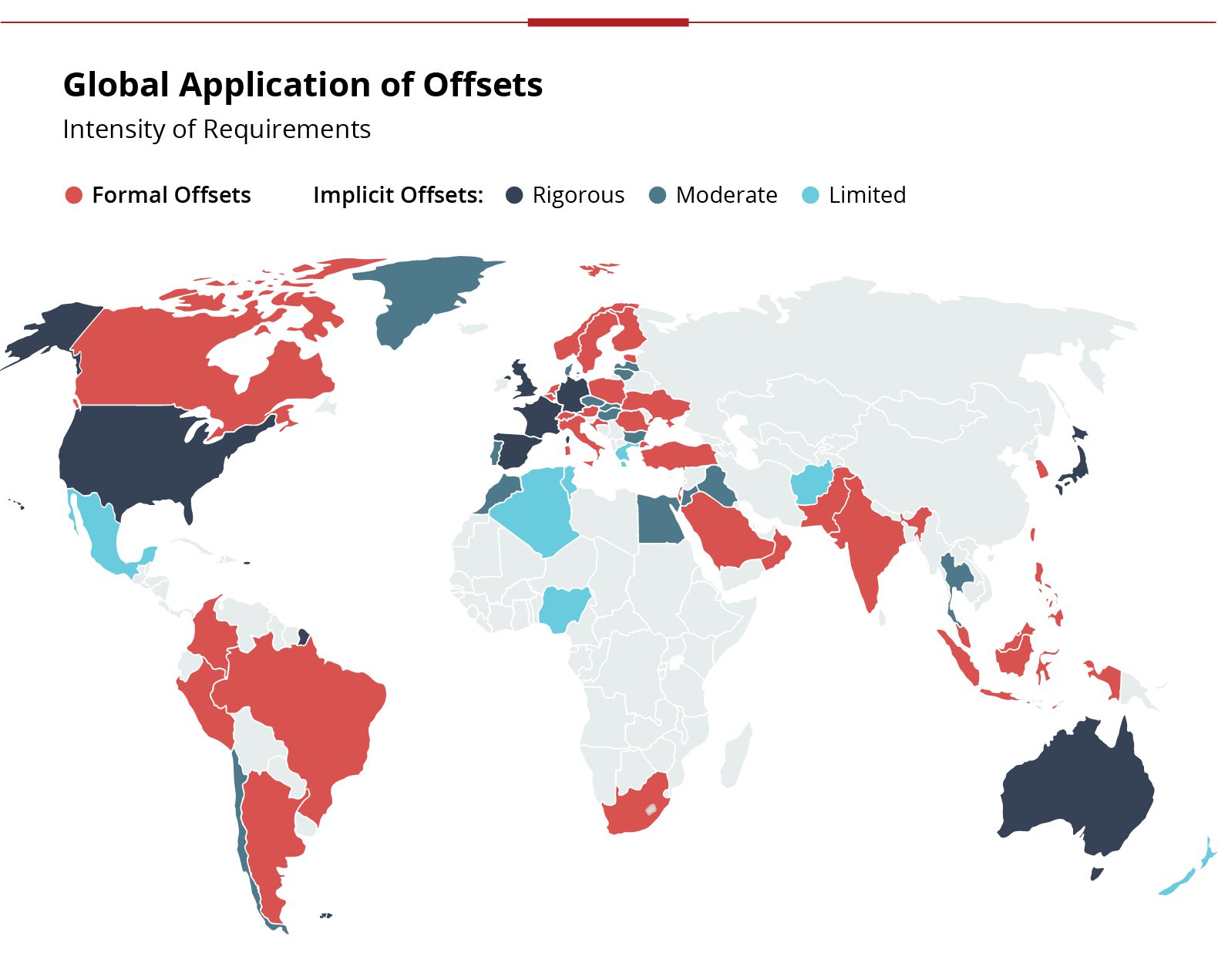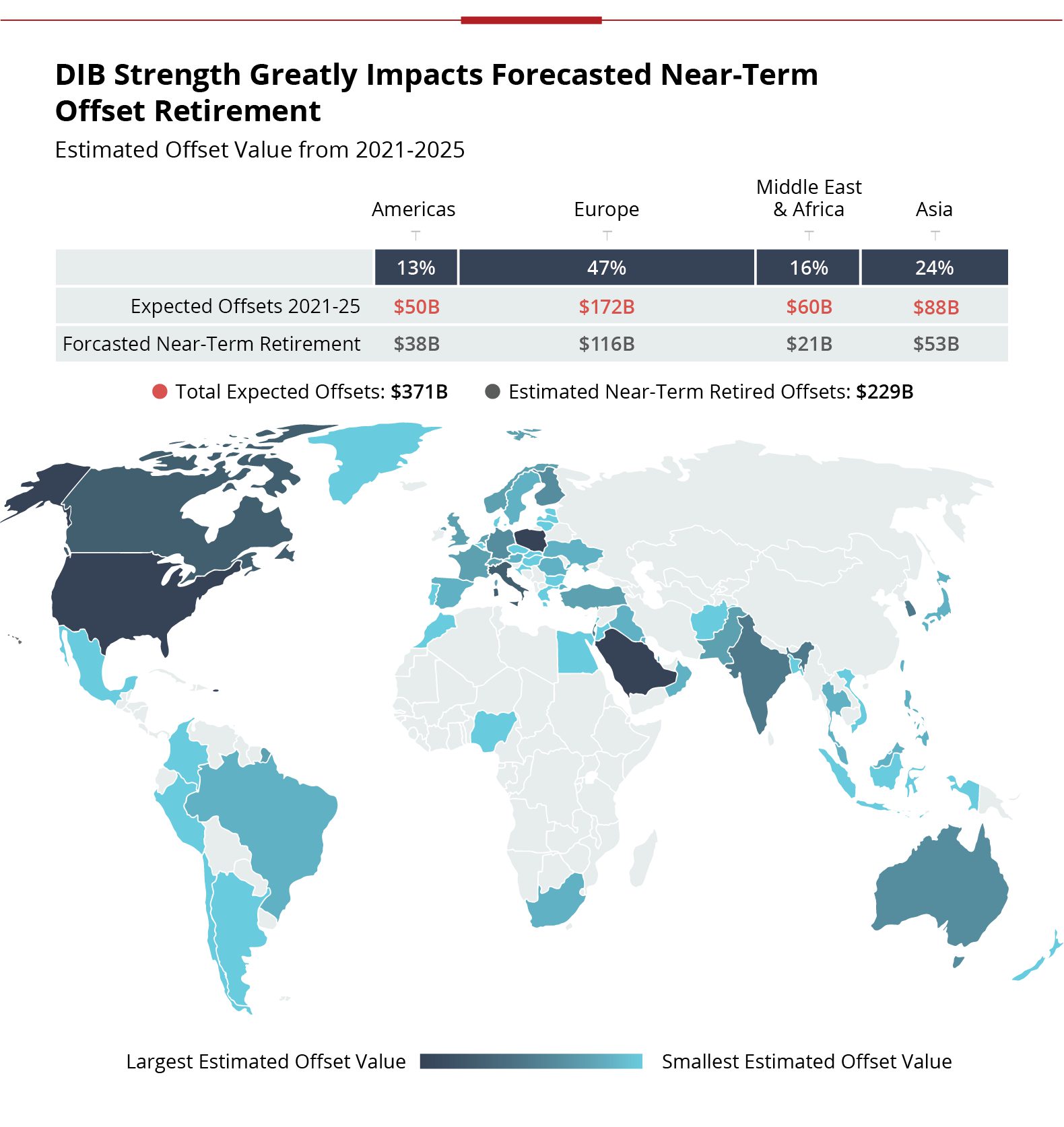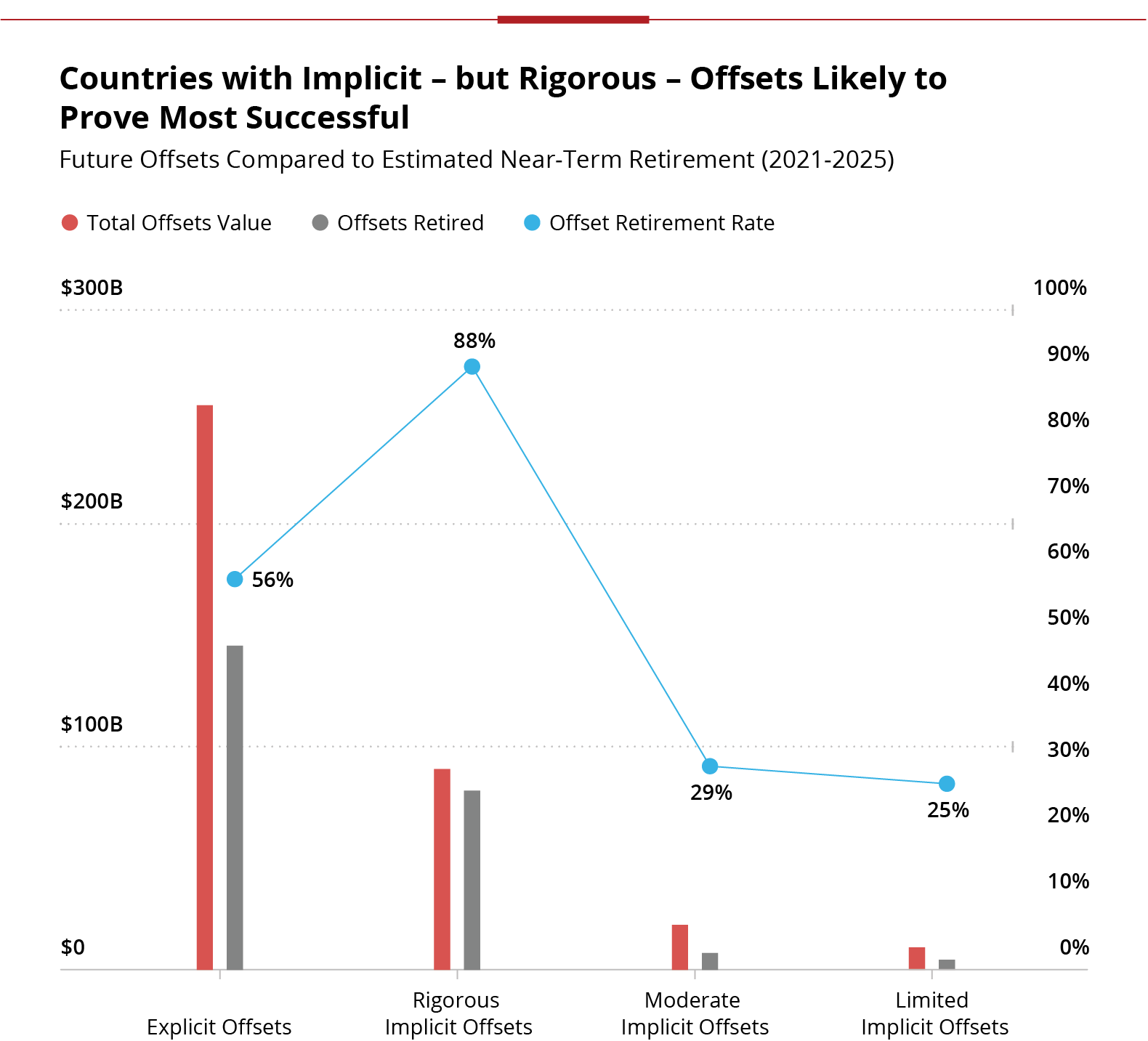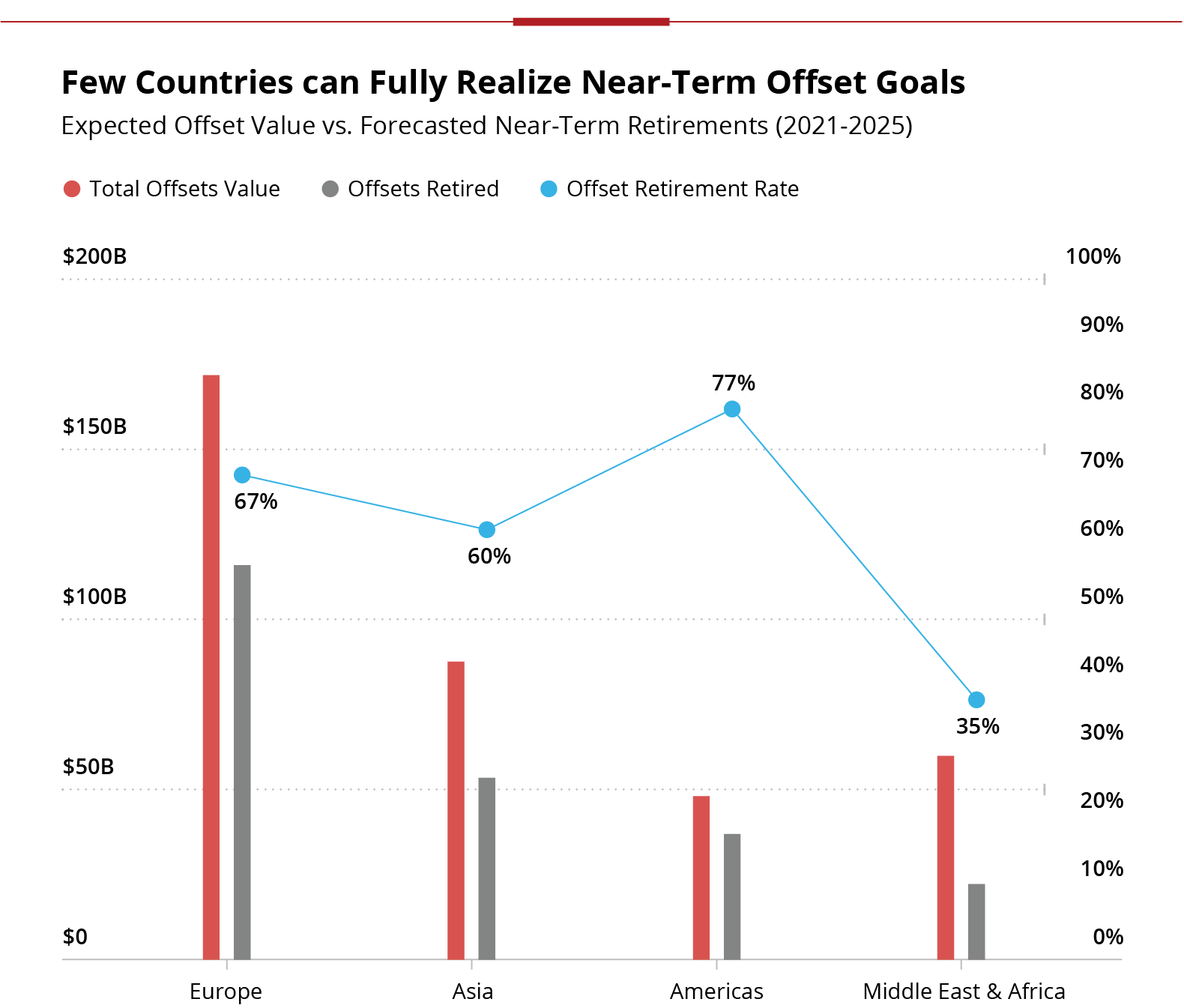Defense Offsets Expectations are Considerable, but Implementation is Uneven
Avascent expects global defense offsets and industrial participation, both explicitly required and implicitly called for as part of defense acquisitions, to close in on $400B over the coming five years.
While this defense industrial strategy is widespread, implementation is uneven, and success often relies on the quality of domestic industry and defense industrial policy.
Introduction
A vital market influencer, defense offsets, industrial participation, and localization (herein used interchangeably) operate in the background of global defense transactions.
Increasingly, the broader universe of localization includes countries instituting implicit or flexible approaches to drive defense industry growth via their defense procurements, though these strategies remain difficult to quantify.
Moreover, considering industrial policies within the context of other critical factors such as the size and sophistication of host countries’ defense industrial base is essential to determining the effectiveness of various government strategies.
Combined, this more comprehensive assessment of defense offset programs as they exist today suggests that stakeholders should temper their expectations regarding the near-term value and impact of even the most creative industrial participation programs and work equally diligently on laying the foundations of a local defense ecosystem ready to effectively absorb opportunities and partnership with foreign providers.
![]()
“Stakeholders should temper their expectations regarding the near-term value and impact of even the most creative industrial participation programs and work equally diligently on laying the foundations of a local defense ecosystem.”
Opportunity Space for Defense Offsets
Why do offsets and localization remain so prominent in the global defense market? Notably, there has long been skepticism surrounding their long-term impact and value, focused principally on how lasting their benefits are to promoting domestic capability, as well as the financial inefficiencies and added cost to defense purchases.
Attempts to regulate formal defense offsets to promote overall economic efficiency have also been uneven, particularly in the European Union (EU), where governments seem unable to resist the temptation to intervene to promote local industry.
As a result, various localization requirements remain, primarily in markets importing considerable defense equipment. Australia, for example, is loath to rely on formal mandates but has nonetheless gravitated towards increasing local defense participation via goals, incentives, and various types of support and implicit guidance.
Three broad externalities drive this enduring support for offset policies and regimes:
Deteriorating Security Outlook: A perfect storm of regional rivalries, local conflicts, resource competition, and assertive positioning by regional powers all act as a catalyst for continued investment in sovereign defense capabilities and localization.
Weakened Partnership Structures: Industrial participation gains strong advocates when traditional alliances, partners, and long-time defense providers fail to deliver, or waiver, in their commitment to long-time customers. This can be the result of politics and export controls (e.g., International Traffic in Arms Regulations or loss of Intellectual Property), fraying alliance structures, competing interests, or other factors.
Public and Budgetary Pressures: While the two items above typically stimulate defense investments, governments worldwide face the devastating budgetary and economic effects of COVID-19, with public and fiscal pressure to redirect spending to health and social concerns, and away from defense. Closely tying defense investment – via offsets, localization, and support for domestic industry – to jobs and economic growth is thus a natural and effective justification for new or sustained military acquisitions.
Reality of Defense Offsets Today
While enthusiasm for traditional offset programs in defense acquisitions may have moderated, localization remains a common requirement in many countries.
Recent self-reported data on US companies’ involvement in offset agreements show a slight decline in offset engagement; yet, these trends are belied by a number of factors such as a singular focus on formal offset regimes that neglect other less formal flavors of industrial participation.
Understanding the entire picture requires methodically quantifying their range, size, and potential for successful implementation.
![]()
“While enthusiasm for traditional offset programs in defense acquisitions may have moderated, localization remains a common requirement in many countries.”
Expanding the Universe: Explicit and Implicit Defense Offsets
To paint a more realistic picture of the near-term impact and size of defense offsets and their successful implementation, one must first evaluate offset regulations and industrial participation policies, segmenting them as follows:
- Formal Defense Offsets/Industrial Participation: Roughly half of the countries (31 in total) had formal offset/industrial participation policies (e.g., Canada, India, Colombia, Saudi Arabia, etc.) where specific thresholds and offset quota percentages are applied to defense procurements.
- “Implicit” Industrial Participation: The remaining 36 countries did not have formal or consistently applied offset policies (e.g., Australia, Singapore, and numerous EU members). Many, however, have implicit goals for foreign OEMs to collaborate with domestic defense industry in order to win defense contracts. These countries fit into three categories below:
- Rigorous Implicit Offsets: Foreign OEMs often partner with either a leading domestic A&D company (e.g., Australia, UK, US) or a domestic partner, subcontractor, or supplier in order to successfully win and deliver on defense programs
- Moderate Implicit Offsets: Local firms are typically encouraged to take on subcontracting positions with the foreign OEM (e.g., Singapore, Denmark, Thailand)
- Limited Implicit Offsets: These countries have more limited A&D industries, and local governments commonly encourage, but rarely demand, smaller roles in the supply chain (e.g., Mexico, Qatar, Vietnam, etc.)

Qualifying the Defense Offset Universe: The Outlook for Successful Programs
What outcomes does this expanded universe of explicit or implicit defense offsets generate? Our experience suggests it is not just the nature of offsets that matters; rather, it is the domestic defense industrial environment.
Unsurprisingly, the more developed and agile the local defense industrial sector, the better chance offsets have of achieving their promise.
To effectively quantify this thinking, we scored the strength of each country’s defense industrial base (DIB) by analyzing defense workforce size, presence of domestic and foreign defense firms, export volumes, and other key drivers.

Estimated 2021-2025 offset agreement figures and near-term retirement projections demonstrate the influence DIB strength has on industrial participation success.
Employing Avascent’s dataset of historical and projected defense sales, we estimate the total value of offsets from 2021-2025 to be worth $371B.
However, taking this analysis a step further and comparing the estimated offset value to each countries’ DIB capabilities, we estimate the value of defense offsets actually expected to be retired over this same period to be an impressive, but more modest, $229B.
The conversion rate of offset requirement to “value delivered” varies significantly across geographic regions and by the types of offset/industrial participation policies (shown below).

Countries with clearly defined, but flexible, offset policies appear best positioned to achieve successful and lasting offset agreement results (2021-2025 forecasts shown).

The Americas and Europe excel at absorbing localization, showcasing how markets with robust DIBs can achieve localization at a more rapid pace (2021-2025) forecasts.
Existing Local Capability Matters
Thus, countries with the strongest DIBs (commonly found in Europe and North America), are the most likely to achieve their industrial participation goals irrespective of the stringency of policies in place.
These countries are home to a number of primes and subcontractors with sufficient capabilities to meet domestic workshare goals with foreign OEMs. Meanwhile, countries in emerging markets (e.g., MENA and parts of the Americas) struggle to achieve the full value of defense offsets as a result of less developed local defense industries.
This begets a “chicken or egg” discussion – should defense offsets create a defense industrial base, or should one exist to absorb localization opportunities? While the truth lies somewhere in the middle, our analysis suggests that governments should first develop a sound understanding of their DIB capabilities and build a foundation for domestic A&D capabilities to achieve real and lasting localization success.
Countries with the greatest offset success are those able to offer foreign OEM obligors some form of a nascent industrial base. For example, in the mid-2000s BAE Systems evaluated over 200 Dutch companies and eventually down selected to 50 partners as part of their industrial cooperation agreement with the Dutch MoD for their order of combat and armored vehicles.
![]()
“This begets a “chicken or egg” discussion—should defense offsets create a defense industrial base, or should one exist to absorb localization opportunities?”
Access to this pool of capable firms helped enable BAE Systems to overdeliver on their contracted offset obligations. Providing primes with a sufficient selection of capable local partners is crucial in setting foreign firms up for successful and enduring localization endeavors.
Countries actively trying to leverage the best of defense offsets need to understand their capabilities and instill policy changes to effectively promote local growth. India has a long-stated desire to grow their local defense sector and has pursued offset requirements to that aim. However, repeated challenges and underperformance have pushed for liberalization of its defense industrial policies.
From a closed defense market, they crept up to a 26% defense FDI, then 49%, and finally 74% in 2020. Similarly, India started out with a singular focus on state-owned domestic firms but grudgingly realized the need to involve India’s vibrant private sector as well.
Creating a more hospitable local defense industrial environment makes partnership more attractive, thus increasing the outlook that localization will deliver on its contracted obligations or implicit expectations. This suggests a number of concrete steps for stakeholders:
Host Governments
Increase Localization Transparency: To attain more value from offset agreements, governments should implement more flexible and transparent offset policies. Clearly stating desired defense industrial capabilities is one approach. For example, in 2018, the Canadian government outlined a list of 16 Key Industrial Capabilities (KICs) under their Industrial and Technological Benefits (ITB) policy to promote targeted investments in distinct focus areas.
Slow & Steady for Developing DIBs: While subcontracting and production may be highly desired by host governments, not all DIBs are well suited for these types of engagements. Host countries with fewer capabilities should focus on narrow industry segments and developing local workforce skills and knowledge skills via technology transfer and training before targeting capital-intensive projects.
Leverage Leading Industry Players: Governments can enable existing commercially-focused national champions to build their domestic defense industrial base, with a focus on high tech, IT, advanced manufacturing, and other areas; however, governments must provide clear incentives, and most importantly, a level playing field with state-owned entities. Commercial cross-over opportunities should be embraced.
Domestic Firms/Local Industry
Lobby for Greater Transparency: In explicit or implicit localization programs, local industry should push the government for realistic, well-structured offset policies. If typically risk-averse foreign OEMs can effectively navigate a country’s offset landscape, they become much more willing to invest and partner with local firms.
Form Industry Partnerships/Alliances: Industry alliances strengthen the domestic A&D workforce, making it easier for foreign firms to do business. Bridging information asymmetries in the defense sector allows foreign companies to better understand and leverage local partnership potential.
Global OEMs
Identify Local Partners: It is crucial to identify a robust pool of potential local partners before striking localization agreements. Although capabilities may vary, having a down-selected core group of partners eases partnership formation. If dedicated local defense players fail to satisfy, look beyond and encourage aspiring entrants.
Understand Client Country Capabilities: OEMs should be educated on local industries’ strengths, weaknesses, and specific areas where the government desires investment, and should market their expertise and understanding of the client country’s capability requirements.



